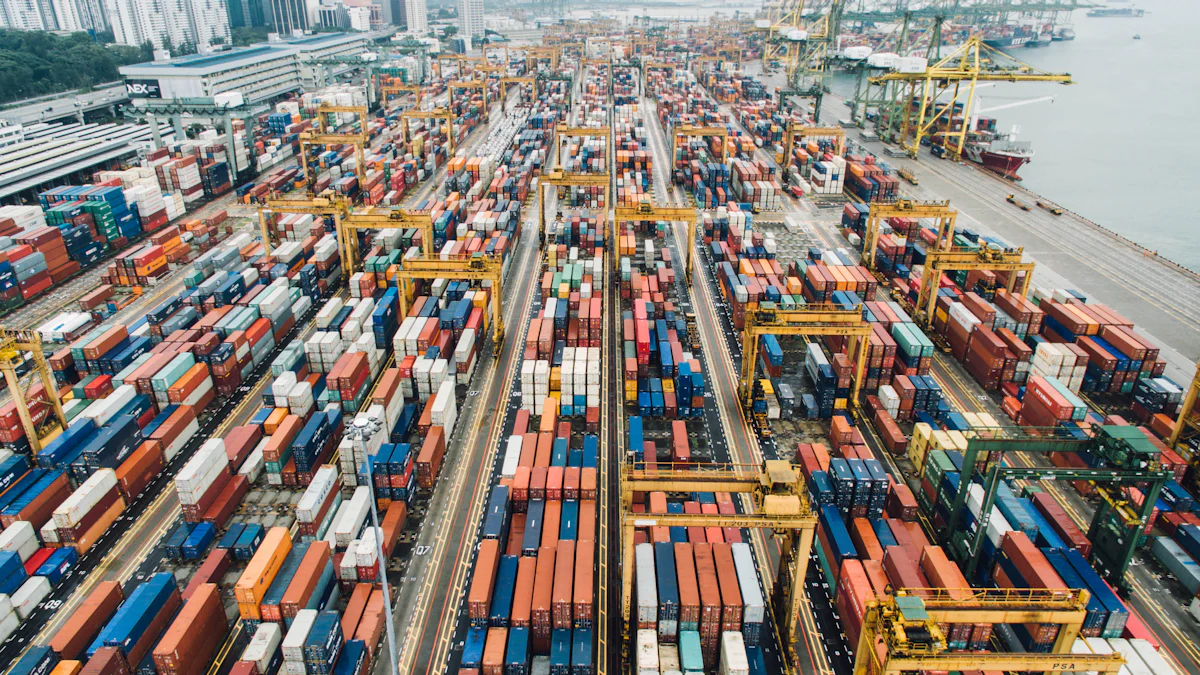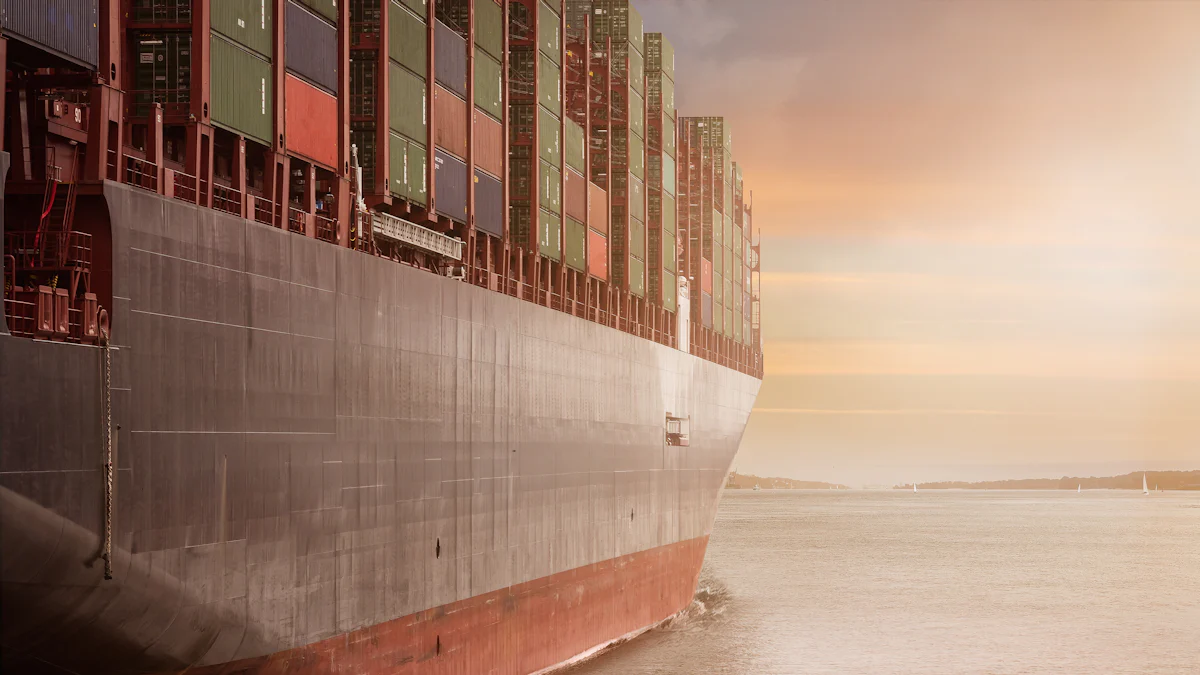Mastering the Freight Shipping Process: Essential Steps

Understanding the freight shipping process is crucial for businesses engaged in global trade. Efficient logistics play a pivotal role in connecting economies and facilitating commerce. The logistics industry contributes approximately 12% of global GDP, highlighting its significance in economic growth. Moreover, maritime traffic handles over 90% of international trade, underscoring the importance of sea freight in moving goods across borders. As the freight forwarding market grows, projected to reach US$ 559.6 million by 2030, mastering the shipping logistics services becomes essential for businesses aiming to thrive in the competitive global market.
Understanding Freight Shipping Basics

Key Terminology
Understanding freight shipping requires familiarity with specific terminology. This knowledge helps businesses navigate the complexities of logistics.
Common Terms
Freight: Refers to goods transported in bulk by truck, train, ship, or aircraft.
Consignment: A batch of goods destined for or delivered to someone.
Carrier: A company that transports goods for any person or company and is responsible for any possible loss of the goods during transport.
Bill of Lading: A legal document issued by a carrier to a shipper, detailing the type, quantity, and destination of the goods being carried.
Industry Jargon
FOB (Free on Board): Indicates that the seller delivers goods on board a vessel designated by the buyer. The seller fulfills their obligation to deliver when the goods have passed over the ship's rail.
ETA (Estimated Time of Arrival): The projected time when a shipment will arrive at its destination.
TEU (Twenty-foot Equivalent Unit): A measure used for capacity in container transportation. It is based on the volume of a 20-foot-long container.
Types of Freight Shipping
Freight shipping involves various modes of transportation, each with unique advantages and considerations.
Air Freight
Air freight offers the fastest delivery times for international shipments. It is ideal for high-value or time-sensitive goods. Although more expensive than other modes, air freight ensures quick transit and high security. According to experts in international shipping, air freight is often chosen for electronics and perishable goods due to its speed and reliability.
Sea Freight
Sea freight is the most cost-effective method for transporting large volumes of goods over long distances. It handles over 90% of international trade, making it essential for global commerce. Sea freight is suitable for non-urgent shipments and bulky items. It provides a balance between cost and capacity, making it a popular choice for businesses.
Land Freight
Land freight includes transportation by truck or rail. It is crucial for domestic and cross-border logistics. Trucks offer flexibility and door-to-door service, while rail provides an economical option for heavy and bulk shipments. Land freight supports the supply chain by connecting ports and airports to final destinations.
Planning and Preparation
Effective freight shipping begins with careful planning and preparation. This stage ensures that businesses meet their shipping needs efficiently and cost-effectively.
Identifying Shipping Needs
Understanding the specific requirements of a shipment is crucial. Businesses must assess various factors to ensure smooth transportation.
Assessing Cargo Type
Different types of cargo require different handling and transportation methods. For instance, perishable goods need refrigeration, while fragile items demand careful packaging. Identifying the cargo type helps in selecting the appropriate shipping method and packaging materials.
Determining Volume and Weight
Accurate measurement of volume and weight is essential. It influences the choice of transportation mode and affects shipping costs. Overestimating or underestimating these factors can lead to logistical challenges and unexpected expenses.
Selecting the Right Carrier
Choosing the right carrier plays a vital role in the shipping process. Businesses must evaluate options to find the best fit for their needs.
Evaluating Carrier Options
Businesses should compare carriers like USPS, UPS, and FedEx. Each offers unique shipping options and services. Evaluating these options helps in selecting a carrier that aligns with specific shipping requirements.
Comparing Costs and Services
Cost comparison is crucial. Businesses should analyze the pricing structures of different carriers. They must also consider the services offered, such as delivery speed and tracking capabilities. This comparison ensures that businesses receive the best value for their shipping needs.
By focusing on these aspects, businesses can streamline their freight shipping process, ensuring efficiency and cost-effectiveness.
Documentation and Compliance
Proper documentation and compliance are crucial in the freight shipping process. They ensure smooth operations and prevent legal issues.
Essential Shipping Documents
Understanding key documents is vital for successful shipping.
Bill of Lading
The Bill of Lading (BOL) serves as a receipt and contract between the shipper and carrier. It includes essential details like the nature of goods, quantity, and destination. This document ensures that the buyer receives the product and the seller gets paid. For international shipments, additional documentation may be required for customs clearance.
Commercial Invoice
The Commercial Invoice contains information about the import or export of goods. It is used for customs declaration and helps authorities decide on duties or taxes. This document is mandatory for every consignment, ensuring that shipments comply with international trade laws.
Understanding Regulations
Compliance with regulations is critical to avoid delays and fines.
International Shipping Laws
International Maritime Laws apply to freight shipments and vary by destination country. Understanding these laws is essential for seamless operations. Different interpretations can affect shipping procedures, so businesses must stay informed about specific requirements.
Customs requirements play a significant role in international shipping. Compliance with these regulations prevents time delays and fines. For example, the Importer Security Filing (ISF) is mandatory for ocean shipments entering the United States. Importers must complete this filing at least 24 hours before the vessel's departure to ensure compliance.
Customs requirements play a significant role in international shipping. Compliance with these regulations prevents time delays and fines. For example, the Importer Security Filing (ISF) is mandatory for ocean shipments entering the United States. Importers must complete this filing at least 24 hours before the vessel's departure to ensure compliance.
By mastering documentation and compliance, businesses can enhance their shipping efficiency and avoid potential pitfalls.
Execution and Monitoring

Efficient execution and vigilant monitoring are crucial in the freight shipping process. These steps ensure that shipments reach their destinations on time and in good condition.
Coordinating Pickup and Delivery
Proper coordination of pickup and delivery schedules is essential for seamless logistics operations.
Scheduling Timelines
Businesses must establish clear timelines for both pickup and delivery. This involves coordinating with carriers to ensure that shipments are collected and delivered according to the planned schedule. Timely scheduling minimizes delays and enhances the overall efficiency of the shipping process. By adhering to a well-structured timeline, companies can optimize their logistics operations and maintain customer satisfaction.
Tracking Shipments
Real-time shipment tracking has transformed global logistics by enhancing operational efficiency and customer satisfaction. Businesses can monitor their shipments in real-time, allowing them to respond promptly to any issues that may arise during transit. This capability is particularly valuable in sectors like pharmaceuticals, where regulatory compliance and product safety are paramount. Real-time tracking ensures that products remain safe and compliant throughout the shipping process. In the manufacturing sector, it streamlines supply chain and inventory management, reducing lead times and improving inventory accuracy.
Managing Risks
Risk management is a critical component of the freight shipping process. It involves identifying potential risks and implementing strategies to mitigate them.
Insurance Options
Insurance provides a safety net for businesses against potential losses during transit. Companies should explore various insurance options to protect their shipments from damage, theft, or loss. By selecting the appropriate insurance coverage, businesses can safeguard their investments and ensure financial stability in the event of unforeseen circumstances.
Contingency Planning
Contingency planning involves preparing for unexpected events that may disrupt the shipping process. Businesses should develop comprehensive contingency plans to address potential challenges such as natural disasters, transportation strikes, or equipment failures. These plans should outline alternative routes, backup carriers, and communication protocols to ensure continuity of operations. By proactively managing risks, companies can maintain the integrity of their supply chain and minimize disruptions.
Shipping Logistics Services with JUSDA
JUSDA offers a comprehensive suite of shipping logistics services designed to meet the diverse needs of businesses across various industries. With a robust network and advanced technology, JUSDA ensures efficient logistics solutions.
Comprehensive Solutions
Air, Land, and Sea Transport
JUSDA provides extensive transportation options, including air, land, and sea freight. These services cater to different shipping needs, ensuring flexibility and efficiency. Air transport offers rapid delivery for time-sensitive shipments, while sea freight provides cost-effective solutions for large volumes. Land transport, encompassing both truck and rail, connects ports and airports to final destinations, facilitating seamless logistics operations.
JusLink Intelligent Supply Chain
The JusLink Intelligent Supply Chain integrates cutting-edge technologies such as the Internet of Things (IoT), cloud computing, and big data. This integration breaks down information silos, enabling real-time collaboration and information sharing across the supply chain. By leveraging these technologies, JUSDA enhances visibility and coordination, ensuring smooth and efficient logistics operations.
Industry-Specific Services
Tailored Solutions for Electronics
JUSDA specializes in providing tailored logistics solutions for the electronics industry. With nearly 20 years of experience in lean supply chain management, JUSDA collaborates with over 5,000 component manufacturers and serves more than 1,000 well-known brand customers. This expertise ensures that electronic products are handled with precision and care, meeting the unique requirements of the industry.
Automotive and FMCG Logistics
In addition to electronics, JUSDA offers specialized logistics services for the automotive and fast-moving consumer goods (FMCG) sectors. These services include end-to-end supply chain integration, from raw materials to finished products. JUSDA's deep integration with customers promotes the supply chain as a core competitive advantage, enhancing efficiency and reducing costs.
By offering comprehensive and industry-specific shipping logistics services, JUSDA positions itself as a leader in global supply chain management. Businesses can rely on JUSDA's expertise and innovative solutions to optimize their logistics operations and achieve success in the competitive global market.
Evaluating and Improving the Process
Analyzing Performance
Effective freight shipping requires continuous evaluation. Businesses must focus on key performance indicators (KPIs) to measure success.
Key Performance Indicators
On-Time Delivery Rate: This KPI tracks the percentage of shipments delivered on schedule. In 2022, 31% of shippers faced challenges with on-time inland container deliveries. Monitoring this metric helps businesses identify areas for improvement.
Shipping Volume Trends: Understanding shipping volumes is crucial. In 2023, 63% of shippers anticipated increased volumes. Tracking these trends allows companies to adjust resources and strategies accordingly.
Capacity Utilization: This measures how effectively a company uses its shipping capacity. In 2022, 22% of shippers struggled with capacity challenges. Optimizing capacity can lead to cost savings and improved efficiency.
Feedback Mechanisms
Gathering feedback from stakeholders enhances the shipping process. Businesses should implement structured feedback systems:
Customer Surveys: Regular surveys provide insights into customer satisfaction and areas needing improvement.
Carrier Reviews: Evaluating carrier performance ensures alignment with business goals.
Internal Assessments: Team evaluations help identify internal process improvements.
Implementing Best Practices
Continuous improvement and technology play vital roles in refining freight shipping.
Continuous Improvement
Businesses should adopt a mindset of ongoing enhancement:
Process Audits: Regular audits identify inefficiencies and areas for optimization.
Training Programs: Investing in employee training ensures that staff remain knowledgeable about best practices and industry standards.
Leveraging Technology
Technology integration transforms logistics operations:
Real-Time Tracking Systems: These systems provide visibility into shipment status, enhancing decision-making and customer satisfaction.
Data Analytics: Analyzing shipping data uncovers patterns and opportunities for improvement.
By focusing on performance analysis and best practices, businesses can enhance their freight shipping processes, ensuring efficiency and competitiveness in the global market.
JUSDA
More than your expectation
Mastering the freight shipping process involves several essential steps. Businesses must understand key terminology, plan meticulously, and ensure compliance with regulations. They should also execute shipments efficiently and continuously evaluate performance. JUSDA offers comprehensive logistics solutions, enhancing efficiency and reliability. Their services cater to diverse industries, providing tailored solutions that meet specific needs. By leveraging JUSDA's expertise, businesses can achieve mastery in freight shipping. As the industry evolves, staying informed and adaptable remains crucial. Embracing these steps ensures success in the dynamic world of global trade.
See Also
Expert Advice for Mastering Risk in Supply Chain Management
2024 Updates: Revealing Sea Freight Logistics Innovations
Unleashing Efficiency: Insider Tips for Saving in Logistics
The Definitive Guide to Reducing Logistics Costs
Revealing the Top Global Logistics Companies: A Comprehensive Guide
